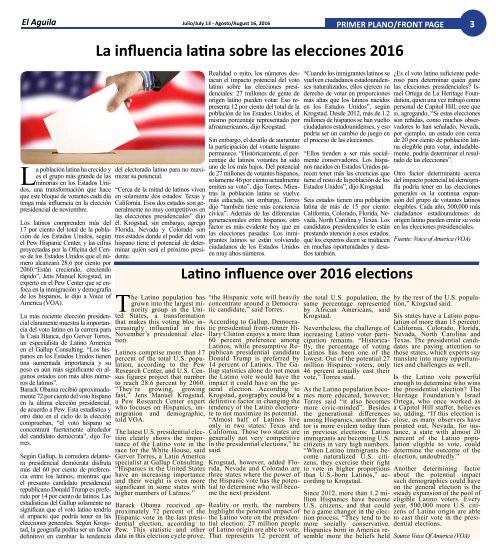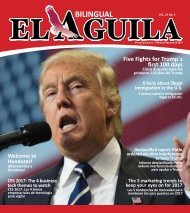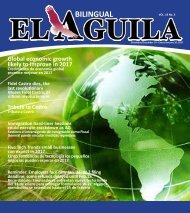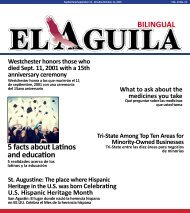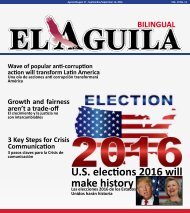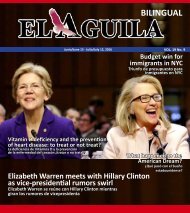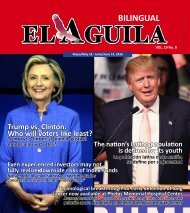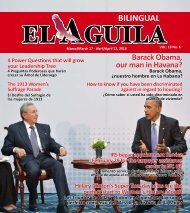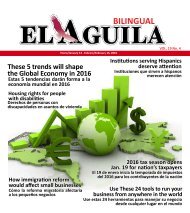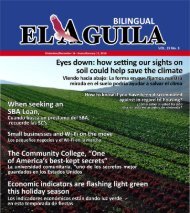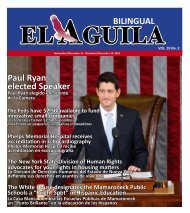El Aguila Magazine – July 13, 2016
You also want an ePaper? Increase the reach of your titles
YUMPU automatically turns print PDFs into web optimized ePapers that Google loves.
<strong>El</strong> <strong>Aguila</strong> Julio/<strong>July</strong> <strong>13</strong> - Agosto/August 16, <strong>2016</strong><br />
PRIMER PLANO/FRONT PAGE<br />
3<br />
La influencia latina sobre las elecciones <strong>2016</strong><br />
La población latina ha crecido y<br />
es el grupo más grande de las<br />
minorías en los Estados Unidos,<br />
una transformación que hace<br />
que este bloque de votantes cada día<br />
tenga más influencia en la elección<br />
presidencial de noviembre.<br />
Los latinos comprenden más del<br />
17 por ciento del total de la población<br />
de los Estados Unidos, según<br />
el Pew Hispanic Center, y las cifras<br />
proyectadas por la Oficina del Censo<br />
de los Estados Unidos que el número<br />
alcanzará 28.6 por ciento por<br />
2060.“Están creciendo, creciendo<br />
rápido”, Jens Manuel Krogstad, un<br />
experto en el Pew Center que se enfoca<br />
en la inmigración y demografía<br />
de los hispanos, le dijo a Voice of<br />
America (VOA).<br />
La más reciente elección presidencial<br />
claramente muestra la importancia<br />
del voto latino en la carrera para<br />
la Casa Blanca, dijo Gerver Torres,<br />
un especialista de Latino America<br />
en el Gallup Consulting. “Los hispanos<br />
en los Estados Unidos tienen<br />
una aumentada importancia y su<br />
peso es aún más significante en algunos<br />
estados con más altos números<br />
de latinos”.<br />
Barack Obama recibió aproximadamente<br />
72 por ciento del voto hispano<br />
en la última elección presidencial,<br />
de acuerdo a Pew. Esta estadística y<br />
otro dato en el ciclo de la elección<br />
comprueban, “el voto hispano se<br />
concentrará fuertemente alrededor<br />
del candidato demócrata”, dijo Torres.<br />
Según Gallup, la corredora delantera<br />
presidencial demócrata disfruta<br />
más del 60 por ciento de preferencia<br />
entre los latinos, mientras que<br />
el presunto candidato presidencial<br />
republicano Donald Trump es preferido<br />
por 14 por ciento de latinos. Las<br />
estadísticas del Gallup solamente no<br />
significan que el voto latino tendría<br />
el impacto que podría tener en las<br />
elecciones generales. Según Krogstad,<br />
la geografía podría ser un factor<br />
definitivo en cambiar la tendencia<br />
del electorado latino para no maximizar<br />
su potencial.<br />
“Cerca de la mitad de latinos viven<br />
en solamente dos estados: Texas y<br />
California. Esos dos estados son generalmente<br />
no muy competitivos en<br />
las elecciones presidenciales” dijo<br />
él. Krogstad, sin embargo, agrego<br />
Florida, Nevada y Colorado son<br />
tres estados donde el poder del voto<br />
hispano tiene el potencial de determinar<br />
quién será el próximo presidente.<br />
The Latino population has<br />
grown into the largest minority<br />
group in the United<br />
States, a transformation<br />
that makes this voting bloc increasingly<br />
influential in this<br />
November’s presidential election.<br />
Latinos comprise more than 17<br />
percent of the total U.S. population,<br />
according to the Pew<br />
Research Center, and U.S. Census<br />
figures project that number<br />
to reach 28.6 percent by 2060.<br />
“They’re growing, growing<br />
fast,” Jens Manuel Krogstad,<br />
a Pew Research Center expert<br />
who focuses on Hispanics, immigration<br />
and demographic,<br />
told VOA.<br />
The latest U.S. presidential election<br />
clearly shows the importance<br />
of the Latino vote in the<br />
race for the White House, said<br />
Gerver Torres, a Latin America<br />
specialist at Gallup Consulting.<br />
“Hispanics in the United States<br />
have an increasing importance<br />
and their weight is even more<br />
significant in some states with<br />
higher numbers of Latinos.”<br />
Barack Obama received approximately<br />
72 percent of the<br />
Hispanic vote in the last presidential<br />
election, according to<br />
Pew. This statistic and other<br />
data in this election cycle prove,<br />
Realidad o mito, los números destacan<br />
el impacto potencial del voto<br />
latino sobre las elecciones presidenciales:<br />
27 millones de gente de<br />
origen latino pueden votar. Eso representa<br />
12 por ciento del total de la<br />
población de los Estados Unidos, el<br />
mismo porcentaje representado por<br />
afroamericanos, dijo Krogstad.<br />
Sin embargo, el desafío de aumentar<br />
la participación del votante hispano<br />
permanece. “Históricamente, el porcentaje<br />
de latinos votantes ha sido<br />
uno de los más bajos. Del potencial<br />
de 27 millones de votantes hispanos,<br />
solamente 46 por ciento actualmente<br />
emiten su voto”, dijo Torres. Mientras<br />
la población latina se vuelve<br />
más educada, sin embargo, Torres<br />
dijo “también tiene más conciencia<br />
cívica”. Además de las diferencias<br />
generacionales entre hispanos, otro<br />
factor es más evidente hoy que en<br />
las elecciones pasadas: Los inmigrantes<br />
latinos se están volviendo<br />
ciudadanos de los Estados Unidos<br />
en muy altos números.<br />
Latino influence over <strong>2016</strong> elections<br />
“the Hispanic vote will heavily<br />
concentrate around a Democratic<br />
candidate,” said Torres.<br />
According to Gallup, Democratic<br />
presidential front-runner Hillary<br />
Clinton enjoys a more than<br />
60 percent preference among<br />
Latinos, while presumptive Republican<br />
presidential candidate<br />
Donald Trump is preferred by<br />
14 percent of Latinos. The Gallup<br />
statistics alone do not mean<br />
the Latino vote would have the<br />
impact it could have on the general<br />
election. According to<br />
Krogstad, geography could be a<br />
definitive factor in changing the<br />
tendency of the Latino electorate<br />
to not maximize its potential.<br />
“Almost half of Latinos live<br />
only in two states: Texas and<br />
California. Those two states are<br />
generally not very competitive<br />
in the presidential elections,” he<br />
said.<br />
Krogstad, however, added Florida,<br />
Nevada and Colorado are<br />
three states where the power of<br />
the Hispanic vote has the potential<br />
to determine who will become<br />
the next president.<br />
Reality or myth, the numbers<br />
highlight the potential impact of<br />
the Latino vote on the presidential<br />
election: 27 million people<br />
of Latino origin are able to vote.<br />
That represents 12 percent of<br />
“Cuando los inmigrantes latinos se<br />
vuelven ciudadanos estadounidenses<br />
naturalizados, ellos ejercen su<br />
derecho de votar en proporciones<br />
más altas que los latinos nacidos<br />
en los Estados Unidos”, según<br />
Krogstad. Desde 2012, más de 1.2<br />
millones de hispanos se han vuelto<br />
ciudadanos estadounidenses, y eso<br />
podría ser un cambio de juego en<br />
el proceso de las elecciones.<br />
“<strong>El</strong>los tienden a ser más socialmente<br />
conservadores. Los hispanos<br />
nacidos en Estados Unidos parecen<br />
tener más las creencias que<br />
tiene el resto de la población de los<br />
Estados Unidos”, dijo Krogstad.<br />
Seis estados tienen una población<br />
latina de más de 15 por ciento:<br />
California, Colorado, Florida, Nevada,<br />
North Carolina y Texas. Los<br />
candidatos presidenciales le están<br />
prestando atención a esos estados,<br />
que los expertos dicen se traducen<br />
en muchas oportunidades y desafíos<br />
también.<br />
the total U.S. population, the<br />
same percentage represented<br />
by African Americans, said<br />
Krogstad.<br />
Nevertheless, the challenge of<br />
increasing Latino voter participation<br />
remains. “Historically,<br />
the percentage of voting<br />
Latinos has been one of the<br />
lowest. Out of the potential 27<br />
million Hispanic voters, only<br />
46 percent actually cast their<br />
vote,” Torres said.<br />
As the Latino population becomes<br />
more educated, however,<br />
Torres said “it also becomes<br />
more civic-minded”. Besides<br />
the generational differences<br />
among Hispanics, another factor<br />
is more evident today than<br />
in previous elections: Latino<br />
immigrants are becoming U.S.<br />
citizens in very high numbers.<br />
“When Latino immigrants become<br />
naturalized U.S. citizens,<br />
they exercise their right<br />
to vote in higher proportions<br />
than U.S.-born Latinos,” according<br />
to Krogstad.<br />
Since 2012, more than 1.2 million<br />
Hispanics have become<br />
U.S. citizens, and that could<br />
be a game changer in the election<br />
process. “They tend to be<br />
more socially conservative.<br />
Hispanics born in America resemble<br />
more the beliefs held<br />
¿Es el voto latino suficiente poderoso<br />
para determinar quién gane<br />
las elecciones presidenciales? Israel<br />
Ortega de La Heritage Foundation,<br />
quien una vez trabajó como<br />
personal de Capitol Hill, cree que<br />
si, agregando, “Si estas elecciones<br />
son reñidas, como muchos observadores<br />
lo han señalado, Nevada,<br />
por ejemplo, un estado con cerca<br />
de 20 por ciento de población latina<br />
elegible para votar, indudablemente,<br />
podría determinar el resultado<br />
de las elecciones”.<br />
Otro factor determinante acerca<br />
del impacto potencial tal demografía<br />
podría tener en las elecciones<br />
generales es la continua expansión<br />
del grupo de votantes latinos<br />
elegibles. Cada año, 500,000 más<br />
ciudadanos estadounidenses de<br />
origen latino pueden emitir su voto<br />
en las elecciones presidenciales.<br />
Fuente: Voice of America (VOA)<br />
by the rest of the U.S. population,”<br />
Krogstad said.<br />
Six states have a Latino population<br />
of more than 15 percent:<br />
California, Colorado, Florida,<br />
Nevada, North Carolina and<br />
Texas. The presidential candidates<br />
are paying attention to<br />
those states, which experts say<br />
translate into many opportunities<br />
and challenges as well.<br />
Is the Latino vote powerful<br />
enough to determine who wins<br />
the presidential election? The<br />
Heritage Foundation’s Israel<br />
Ortega, who once worked as<br />
a Capitol Hill staffer, believes<br />
so, adding, “If this election is<br />
close, as many observers have<br />
pointed out, Nevada, for instance,<br />
a state with almost 20<br />
percent of the Latino population<br />
eligible to vote, could<br />
determine the outcome of the<br />
election, undoubtedly.”<br />
Another determining factor<br />
about the potential impact<br />
such demographics could have<br />
on the general election is the<br />
steady expansion of the pool of<br />
eligible Latino voters. Every<br />
year, 500,000 more U.S. citizens<br />
of Latino origin are able<br />
to cast their vote in the presidential<br />
elections.<br />
Source Voice Of America (VOA)


